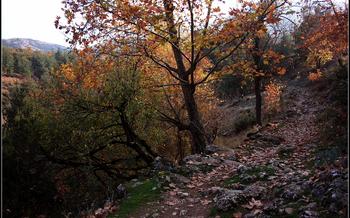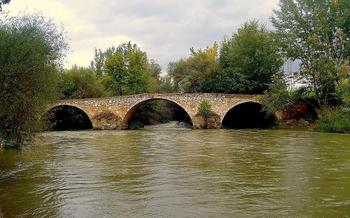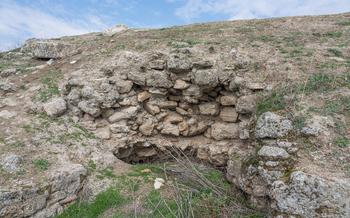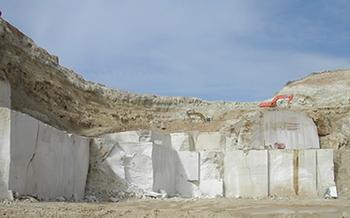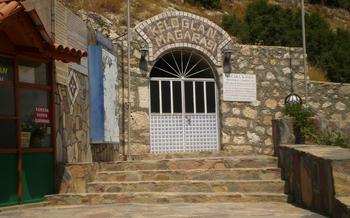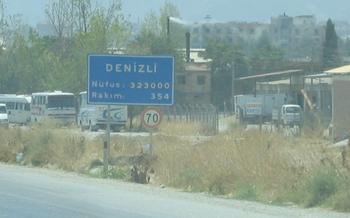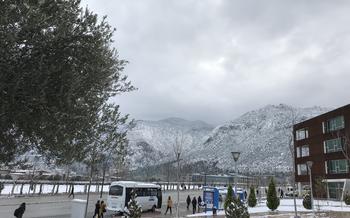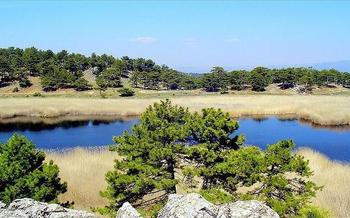
Keloğlan Cave
- Keloğlan Cave: An Enchanting Natural Wonder
- Location and Accessibility
- Exploring the Cave's Interior
- Geological Significance
- Archaeological Findings
- Local Legends and Myths
- Cave Tours and Activities
- Cultural Significance
- Natural Beauty and Scenery
- Conservation and Sustainability
- Nearby Attractions
- Planning Your Visit
- Safety Precautions
- Insider Tips: Unraveling the Cave's Secrets
Keloğlan Cave: An Enchanting Natural Wonder
The Keloğlan Cave, located in the Denizli province of Turkey, is a subterranean treasure that captivates visitors with its enchanting beauty and rich history. Carved by the relentless flow of water over millions of years, this natural wonder boasts a mesmerizing array of geological formations, including towering stalactites and delicate stalagmites that create an ethereal ambiance. According to local folklore, the cave takes its name from the legendary figure of Keloğlan, a mischievous trickster character often featured in Turkish fairy tales. Legends speak of Keloğlan's secret hideouts within the cave, adding a touch of mystery and enchantment to its allure.
The cave's geological significance lies in its unique rock formations and the diverse ecosystems it harbors. Its chambers and tunnels are adorned with intricate patterns and textures, formed by the deposition of minerals over time. Within its depths, one can observe the ongoing geological processes of speleogenesis, witnessing the creation of new cave features.
Conservation Efforts and Sustainable Tourism Practices Recognizing the fragility of this natural wonder, conservation efforts are underway to protect and preserve the Keloğlan Cave. Sustainable tourism practices are implemented to minimize human impact on the cave environment. Guided tours are conducted responsibly, ensuring visitors have a memorable experience while respecting the cave's delicate ecosystem. Visitors are encouraged to adhere to strict guidelines, such as avoiding touching or damaging the cave formations, using designated walkways, and refraining from littering. Through these efforts, the Keloğlan Cave remains a pristine and awe-inspiring destination for generations to come.
Location and Accessibility
The Keloğlan Cave is situated in the mesmerizing Denizli province of Turkey, nestled amidst the picturesque landscapes of the Honaz Mountain. To reach this subterranean wonder, visitors can embark on a scenic road trip from the city center of Denizli, which takes approximately 1 hour and 30 minutes. Along the way, travelers can admire the region's stunning natural beauty, dotted with charming villages and lush greenery.
Once in Honaz, follow the signs leading to the Keloğlan Cave. The cave is easily accessible by car, and ample parking facilities are available for visitors' convenience. Guided tours are offered throughout the day, providing an informative and immersive experience for those seeking a deeper understanding of the cave's captivating history and geological significance. Local guides, well-versed in the cave's secrets, are eager to share their knowledge and ensure a memorable visit for all.
Exploring the Cave's Interior
Venturing into the Keloğlan Cave is like embarking on a journey through a subterranean wonderland. The cave's chambers and tunnels unfold like a labyrinth, each revealing its own unique features. As you step inside, you'll be greeted by towering rock formations, shaped by eons of water erosion into fantastical shapes that resemble mythical creatures and ancient ruins.
The cave's highlight is undoubtedly its stunning array of stalactites and stalagmites. These calcite deposits, formed by the slow dripping of water over millions of years, create a mesmerizing spectacle. The stalactites, hanging like chandeliers from the ceiling, and the stalagmites, rising from the floor like giant pillars, form intricate patterns and delicate curtains that shimmer in the dim light.
The cave's interior is illuminated by a carefully designed lighting system that enhances the natural beauty of the formations without compromising the cave's delicate ecosystem. Visitors can safely navigate the cave's chambers and tunnels thanks to well-maintained walkways and handrails. The duration of a typical cave exploration varies depending on the chosen tour, but most guided tours last around an hour, allowing visitors ample time to marvel at the cave's wonders.
Geological Significance
The Keloğlan Cave is a geological wonder that has been shaped over millions of years by the relentless forces of nature. The cave's intricate network of chambers, tunnels, and formations is a testament to the Earth's dynamic processes.
The cave is predominantly composed of limestone, a sedimentary rock formed from the accumulation of calcium carbonate over time. The limestone layers were deposited during the Miocene epoch, approximately 23 to 5 million years ago, when the area was covered by a shallow sea. As the sea level fluctuated, the limestone beds were exposed to weathering and erosion, which gradually carved out the cave's subterranean labyrinth.
The cave's geological significance lies in its well-preserved speleothems, which are mineral deposits that form inside caves. These formations, such as stalactites, stalagmites, and flowstones, provide valuable insights into the cave's history and environment. The speleothems are composed primarily of calcite, a form of calcium carbonate, which is deposited by dripping water. The shapes and sizes of these formations vary depending on the flow rate of the water, the humidity, and the temperature inside the cave.
The Keloğlan Cave also offers a glimpse into the region's paleontological history. Fossil discoveries within the cave have revealed the presence of ancient animal and plant life, including bones of extinct species such as cave bears and saber-toothed cats. These findings have contributed to our understanding of the region's biodiversity and the changes that have occurred over geological time.
By studying the geological formations, speleothems, and fossils found in the Keloğlan Cave, scientists have gained valuable knowledge about the area's geological evolution, climate history, and ancient life. The cave serves as a natural laboratory for ongoing research and contributes to our understanding of the Earth's complex geological processes.
Archaeological Findings
The Keloğlan Cave has yielded a wealth of archaeological treasures, providing valuable insights into the lives of past inhabitants and the region's rich cultural heritage. Excavations have uncovered historical artifacts, remnants of ancient tools, pottery shards, and even skeletal remains, offering clues to the cave's past usage and significance.
These discoveries suggest that the cave served as a shelter or temporary dwelling place for prehistoric humans, possibly during seasonal migrations or as a refuge during times of conflict. The presence of hearths, cooking utensils, and storage pits indicates that the cave was used for domestic purposes, with evidence of food preparation and consumption.
Ongoing research projects continue to shed light on the cave's archaeological significance. Archaeologists are meticulously documenting and analyzing the artifacts, studying their context, and piecing together the puzzle of human activity within the cave. These findings contribute to our understanding of ancient civilizations, their adaptation to diverse environments, and the cultural evolution of the region.
Local Legends and Myths
For centuries, the Keloğlan Cave has been a source of fascination and inspiration for local storytellers and mythmakers. According to a popular legend, the cave was once home to a mischievous and clever young boy named Keloğlan. Keloğlan, with his quick wit and cunning, outsmarted and defeated a powerful giant who terrorized the region. In another tale, the cave is said to be the dwelling of a beautiful fairy princess who enchanted and protected the forest around the cave. These legends are deeply intertwined with the cultural heritage of the region, and guides often share these stories during cave tours, adding a touch of magic and enchantment to the exploration.
Cave Tours and Activities
For an unforgettable underground adventure, guided cave tours led by experienced guides are available. These tours offer a chance to explore the cave's hidden chambers and tunnels, marvel at its stunning rock formations, and learn about its geological and historical significance. The tours are designed for visitors of all ages and fitness levels, with varying durations and difficulty levels to choose from.
Families and children can opt for shorter, easier tours that focus on the cave's most accessible and family-friendly areas. Adventure enthusiasts, on the other hand, can embark on more challenging expeditions that delve deeper into the cave's unexplored regions. Visitors can capture the beauty of the cave's interior through photography and videography, but they should adhere to the guidelines provided by the tour guides to ensure minimal impact on the cave environment. Special tours or programs may also be arranged for groups or individuals with specific interests, such as geology, archaeology, or photography.
Cultural Significance
For many local communities, the Keloğlan Cave holds deep cultural and spiritual significance. It has been a sacred site for centuries, woven into the fabric of the region's traditions, rituals, and festivals. The cave's unique formations, stalactites, and stalagmites have been imbued with symbolic and mystical meanings, inspiring awe and reverence among the locals.
Storytelling and guided tours often incorporate these legends, bringing to life the characters, events, and symbolism that have shaped the cultural heritage of the region. The cave serves as a living testament to the intertwined relationship between nature and culture, embodying the essence of the region's identity and heritage.
Natural Beauty and Scenery
The Keloğlan Cave is a feast for the eyes, showcasing a kaleidoscope of natural wonders. Its unique rock formations, shaped by water erosion over millions of years, create a surreal landscape that captivates visitors. The cave's walls and ceilings are adorned with colorful mineral deposits, adding to its visual appeal. Underground rivers and waterfalls cascade through the cave, creating a symphony of sound and movement. Crystal-clear pools reflect the shimmering light, revealing a hidden world beneath the surface. The cave's diverse flora and fauna add to its natural beauty, with rare species of plants and animals thriving in this unique environment. Nature photography enthusiasts will find endless opportunities to capture the cave's stunning scenery, while wildlife observers can spot bats, insects, and other creatures that call the cave their home.
Conservation and Sustainability
Preserving the pristine beauty of Keloğlan Cave and its fragile ecosystem is paramount. Conservation efforts aim to minimize human impact on this natural wonder while promoting sustainable tourism practices. Visitors are encouraged to tread lightly, adhering to designated paths and refraining from touching or damaging rock formations. Proper waste disposal and avoiding the use of flash photography help protect the cave's delicate environment. Educational programs raise awareness about the importance of conservation, ensuring that future generations can appreciate this subterranean marvel.
Nearby Attractions
Beyond the enchanting Keloğlan Cave, Denizli offers a wealth of additional attractions to captivate visitors. The region boasts a diverse array of natural wonders, historical sites, and cultural landmarks, ensuring an unforgettable journey for every traveler.
Pamukkale: A UNESCO World Heritage Site, Pamukkale is renowned for its cascading white travertine terraces and geothermal hot springs. Visitors can explore the ancient ruins of Hierapolis, stroll amidst the cotton-like formations, and bathe in the therapeutic thermal waters.
Laodicea: Just a short drive from Denizli, the ancient city of Laodicea offers a glimpse into the region's rich history. Explore the well-preserved ruins of this once-prosperous city, including its impressive theater, colonnaded streets, and monumental gateways.
Karahayıt: Situated on the shores of Lake Eğirdir, Karahayıt is a picturesque town known for its thermal springs and historic Ottoman architecture. Relax in the soothing thermal baths, wander through the charming streets adorned with traditional houses, and indulge in delicious local cuisine.
Salda Lake: Often referred to as Turkey's Maldives, Salda Lake is a breathtaking natural wonder with its crystal-clear turquoise waters and pristine white shores. Spend a day swimming, sunbathing, or simply marveling at the lake's stunning beauty.
Kaklık Cave: Located near Denizli, Kaklık Cave is another fascinating natural attraction. Explore the cave's vast chambers and tunnels, adorned with impressive stalactites and stalagmites, and discover the hidden underground world beneath the earth's surface.
Planning Your Visit
For an optimal experience, it's crucial to plan your visit to the Keloğlan Cave carefully. While the cave is open year-round, the best time to visit is during the shoulder seasons, spring (April-May) and autumn (September-October), when the weather is pleasant and the crowds are smaller. Summer months can be hot and crowded, while winter temperatures can drop significantly, making exploration less comfortable.
When planning your trip, consider spending at least a day in the area to fully immerse yourself in the cave's wonders. This will give you ample time to explore the cave's chambers, learn about its history, and enjoy the surrounding natural beauty. If you're an avid cave enthusiast or have a particular interest in geology or archaeology, you may want to extend your stay for further exploration or to participate in specialized tours or workshops.
Accommodation options near the cave range from cozy guesthouses and family-run hotels to luxurious resorts. Whether you prefer a budget-friendly stay or a more upscale experience, there are plenty of choices to suit your preferences and budget.
Pack accordingly for your cave adventure. Comfortable, sturdy shoes with good traction are essential for navigating the cave's uneven surfaces. Wear layers of clothing to adjust to the changing temperatures inside the cave. A camera with a flash is recommended to capture the cave's stunning formations in all their glory. Don't forget a bottle of water and a small snack to keep yourself hydrated and energized during your exploration.
Safety Precautions
Exploring the Keloğlan Cave requires adherence to safety guidelines and regulations. Visitors should wear appropriate footwear with good traction to prevent slipping on wet or uneven surfaces. Sturdy clothing that covers the arms and legs is recommended to protect against sharp rock formations or insects.
Inside the cave, it's crucial to be aware of potential hazards such as narrow passages, low ceilings, and slippery surfaces. Visitors should avoid touching or disturbing the cave formations as they are delicate and irreplaceable. Using flashlights or headlamps is essential for navigating the cave safely, and visitors should carry extra batteries or a backup light source.
In case of an emergency, visitors should remain calm and follow the instructions provided by the tour guide or cave management. Emergency exits and contact information are usually displayed at the cave entrance, and visitors should familiarize themselves with these details before entering the cave.
By following these safety precautions, visitors can ensure a safe and enjoyable exploration of the Keloğlan Cave.
Insider Tips: Unraveling the Cave's Secrets
Beyond the main tourist routes, the Keloğlan Cave holds hidden gems waiting to be discovered by adventurous explorers. Venture into lesser-known chambers to witness awe-inspiring rock formations and secluded underground pools that shimmer under the cave's natural lighting. For photography enthusiasts, secret photo spots offer unique angles and perspectives to capture the cave's beauty.
Indulge in the local culinary delights by trying traditional dishes at nearby restaurants. Savor the flavors of authentic Turkish cuisine, from succulent kebabs to fresh seafood, that will tantalize your taste buds and complete your cave exploration experience.
Time your visit to coincide with special events or festivals related to the cave. These celebrations showcase the cultural significance of the site and offer a glimpse into the local traditions and folklore. Immerse yourself in the vibrant atmosphere and create unforgettable memories during your journey to the Keloğlan Cave.
